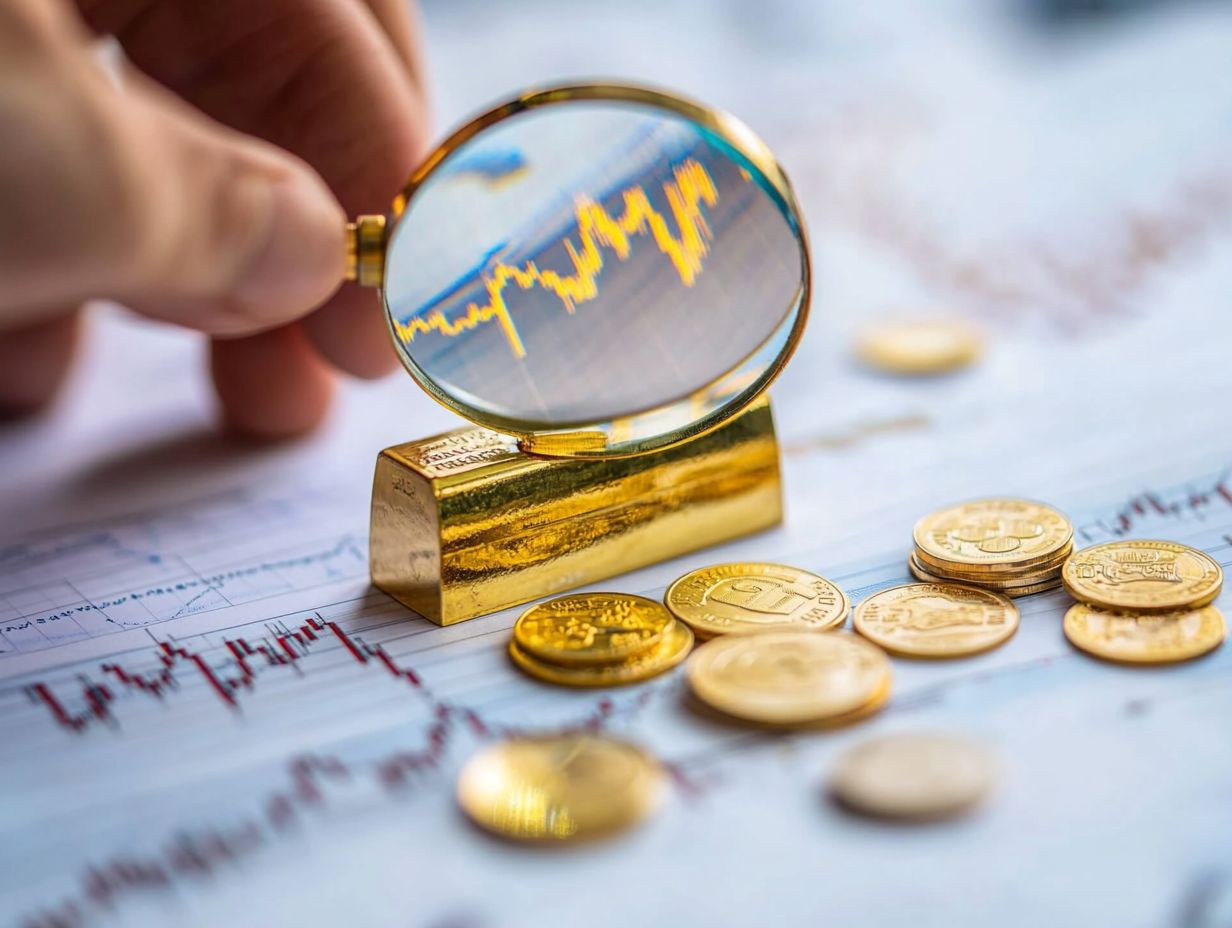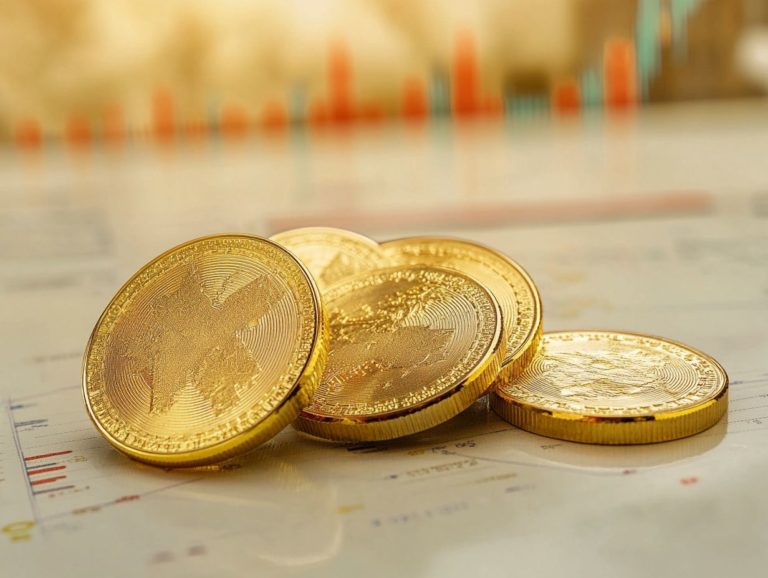5 Common Mistakes in Gold Investments
Investing in gold offers a potentially rewarding opportunity, yet it’s all too easy to fall into traps that could derail your financial objectives.
Here are five common missteps that many investors make, ranging from grappling with the complexities of the gold market to neglecting crucial factors like diversification and storage costs.
In this section, you will explore strategies to steer clear of scams, grasp various investment methods, and consider the tax implications tied to your decisions.
Whether you’re an experienced investor or just beginning your journey, being well-informed can significantly impact your success in gold investment. Immerse yourself in this knowledge to ensure you’re navigating the right path!
Contents
- Key Takeaways:
- 1. Buying Gold Without Understanding the Market
- 2. Focusing Only on Physical Gold
- 3. Not Diversifying Your Gold Portfolio
- 4. Ignoring the Cost of Storage and Insurance
- 5. Falling for Scams and Fraudulent Schemes
- What Are the Different Ways to Invest in Gold?
- Frequently Asked Questions
- What are the 5 common mistakes in gold investments?
- Why is it important to do research before investing in gold?
- How can timing the market impact gold investments?
- Why is diversifying your gold portfolio important?
- What costs should be considered when investing in gold?
- Why is having a long-term plan important for gold investments?
Key Takeaways:

- Do your research before investing in gold to understand the market, its trends, and potential risks.
- Consider diversifying your gold portfolio by investing in different forms, such as stocks or ETFs, rather than solely physical gold.
- Don’t overlook the costs of storing and insuring your gold, as they can impact your overall investment returns.
1. Buying Gold Without Understanding the Market
Investing in gold without a solid grasp of the market can lead to serious financial missteps. It s essential for you to conduct thorough research on market prices, gold values, and the economic factors driving these fluctuations, such as inflation and economic instability.
Understanding various gold assets think gold coins and bullion will significantly enhance your investment strategy. Keeping a pulse on market trends and price movements is crucial for making informed decisions.
Pay close attention to external economic factors, such as geopolitical events and shifts in currency strength, as these can have a profound impact on gold prices. Diving into different gold products is vital for your success.
Relying on trustworthy sources, market reports, and expert analyses will help you navigate this intricate landscape with confidence. Beware of common pitfalls, such as rushing into purchases without proper research.
Neglecting long-term market cycles can lead to regrettable investment outcomes. By cultivating a well-rounded perspective of the market, you can strategically position yourself to maximize your potential returns.
2. Focusing Only on Physical Gold
While physical gold, like coins and bullion, holds immense appeal for many investors, focusing exclusively on these tangible assets could restrict the potential of a truly diversified investment strategy. Expanding your horizons to include options like gold IRAs and various gold products can enhance your portfolio s robustness.
Don t miss out on the opportunity to diversify your investments! Consider including a range of gold-related vehicles, such as gold ETFs, which provide a convenient way to gain exposure to gold prices.
These options help you avoid the hassles of storage and security. This broader strategy can significantly reduce risks, enabling you to capitalize on market fluctuations while maintaining a safeguard against economic uncertainty.
A gold IRA adds an extra layer of security and tax benefits, allowing you to invest in gold while enjoying the protective features of a retirement account. Ultimately, this approach supports a balanced and resilient investment portfolio.
3. Not Diversifying Your Gold Portfolio
Neglecting to diversify your gold portfolio can expose you to unnecessary risks. A balanced investment strategy that incorporates various gold products serves as a robust protection against rising prices, enhancing your financial stability.
By diversifying across different types of gold assets, such as ETFs that track gold prices, mining stocks, and even jewelry, you can tap into various market segments. This strategy effectively shields you against sudden price fluctuations.
A diverse gold portfolio often reacts differently to market trends, leading to improved returns over time. Are you ready to explore the diverse world of gold investments?
4. Ignoring the Cost of Storage and Insurance

Overlooking the costs of storage and insurance can greatly impact your profitability in physical gold and coins. It s essential to have a strategy that includes these necessary expenses.
Consider various storage options. You could use a home safe, a safety deposit box, or a professional vault service. Each option comes with different security levels and accessibility. Weigh the convenience of home storage against the added security of third-party facilities.
It’s also important to secure insurance for valuable metals. This protects you from unexpected events like theft or damage.
Understanding these costs can help you budget better. Regularly evaluate these expenses and set aside a specific budget for storage and insurance to keep your investment portfolio strong while minimizing risks.
5. Falling for Scams and Fraudulent Schemes
Stay alert for scams and fraudulent schemes in the gold market. Falling victim can lead to significant financial losses.
Being well-informed is crucial today. Over 90% of gold investors have encountered misleading ads or rogue dealers.
To protect yourself, watch for red flags. These include unrealistic profit promises or high-pressure sales tactics. Research gold prices, market trends, and reputable dealers to navigate these risks.
Choose a licensed dealer with positive reviews. Many investors who conducted thorough research reported higher satisfaction and a lower risk of scams.
What Are the Different Ways to Invest in Gold?
Investing in gold offers various methods, each with its advantages and disadvantages. You can buy physical gold like coins and bullion or explore gold IRAs to enhance your portfolio.
Gold exchange-traded funds (ETFs) are another option. They let you buy shares representing a specific amount of gold, providing flexibility similar to stocks.
While physical gold is a tangible asset, it often requires secure storage and insurance. Gold IRAs offer tax advantages but come with regulations and fees.
Market prices impact each method. Rising gold prices favor ETFs and bullion, while fluctuating values may make gold IRAs look like a stable long-term investment. To avoid pitfalls, be aware of the 5 common mistakes in gold investment strategies. Your choice should align with your investment strategy and financial goals.
What Are the Advantages and Disadvantages of Each Method?
Each investment method comes with its own unique advantages and disadvantages. Understanding these is key to forming an effective strategy aligned with your financial goals and risk tolerance.
For instance, physical gold like coins or bullion gives you a real asset. Consider the costs of storage and insurance associated with this investment.
Gold IRAs provide tax benefits, but they come with restrictions on transactions and contributions.
Gold ETFs allow easy trading on the stock market and have lower overhead costs, but they lack the physical ownership some investors prefer.
Market fluctuations will affect your returns across these types. It s crucial to align your choices with your overall financial strategy.
How Can One Stay Informed about the Gold Market?

Staying informed about the gold market is crucial for investors aiming to make astute investment decisions and navigate price movements with confidence. This requires diligent research and engagement with trustworthy sources.
Leveraging a variety of resources can significantly enhance your efforts. Financial news outlets deliver timely updates on market fluctuations, while comprehensive market reports provide insights into broader economic trends that can influence gold prices. Additionally, expert analyses from seasoned professionals can reveal the intricate factors affecting market sentiment, giving you the power to make well-informed choices.
By incorporating these resources into your investment strategy, you can deepen your understanding of this precious commodity.
What Are the Potential Risks of Investing in Gold?
While you may view investing in gold as a stable option, it s important to recognize that it comes with its own specific risks. Price fluctuations can impact your gold assets significantly and its effectiveness as a hedge against inflation.
The gold market is influenced by a multitude of factors, including geopolitical tensions, interest rate changes, and currency strength shifts. This makes it crucial for you to stay vigilant and informed. Consider the financial crisis of 2008, when gold prices surged, highlighting its allure as a safe haven. Yet, in the years that followed, those prices experienced notable declines, revealing the inherent volatility of this asset class. If you’re also considering investing in silver, be aware of the 5 mistakes to avoid when investing in silver to navigate this market effectively.
In fact, from 2011 to 2015, the price of gold dropped over 40%, illustrating the dramatic swings that can occur. Understanding these dynamics is essential for aligning your financial goals with your investment decisions.
How Can One Avoid Falling for Gold Investment Scams?
Act quickly to protect yourself against gold investment scams. Conduct thorough research and verify the credibility of coin dealers and online marketplaces before making any purchases.
Start by checking reviews and ratings on platforms like the Better Business Bureau or Trustpilot. Seek out dealers who are members of reputable trade organizations, as this often reflects a commitment to ethical practices. Always request documentation proving product authenticity, such as certificates of authenticity for coins or bars.
Be vigilant for common scams, such as misrepresented pricing, where dealers inflate costs, and counterfeit products that may look genuine but are worth significantly less. By staying informed about these risks, you can make confident decisions and safeguard your investments.
What Are the Tax Implications of Investing in Gold?
Understanding the tax implications of investing in gold is crucial for maximizing your returns, especially when exploring options like gold IRAs, which come with distinct tax benefits in the precious metals arena.
You need to be aware of various tax obligations, such as capital gains tax a tax on the profit you make when selling your gold. The intricacies of gold IRAs deserve your attention; they allow for tax-deferred growth but must comply with specific regulations regarding the types of gold that qualify for investment.
To navigate these tax implications effectively, consider the following steps:
- Keep meticulous records of your purchases and sales.
- Consult a tax professional for tailored advice.
- Think about holding gold in a retirement account to optimize your tax benefits.
By staying informed and proactive, you can elevate your financial outcomes while minimizing tax burdens.
Frequently Asked Questions

What are the 5 common mistakes in gold investments?
- Not doing enough research.
- Timing the market incorrectly.
- Not diversifying the portfolio.
- Failing to consider storage and insurance costs.
- Investing without a long-term plan.
Why is it important to do research before investing in gold?
Researching before investing in gold is critical. It helps you understand market trends and potential risks, ensuring you make informed choices.
How can timing the market impact gold investments?
Timing the market means trying to buy low and sell high. However, it’s nearly impossible to predict fluctuations, which can lead to missed chances and losses.
Why is diversifying your gold portfolio important?
Diversifying means spreading your investments across various forms of gold. Consider physical gold, gold stocks, and gold ETFs, which are Exchange-Traded Funds. This approach reduces the risk of losing everything if one area underperforms.
What costs should be considered when investing in gold?
When investing in gold, don’t forget to consider storage and insurance costs. Ignoring these fees can eat into your profits over time.
Why is having a long-term plan important for gold investments?
A long-term plan keeps you focused on your goals. It helps you avoid impulsive decisions and maximizes potential gains while minimizing losses.















